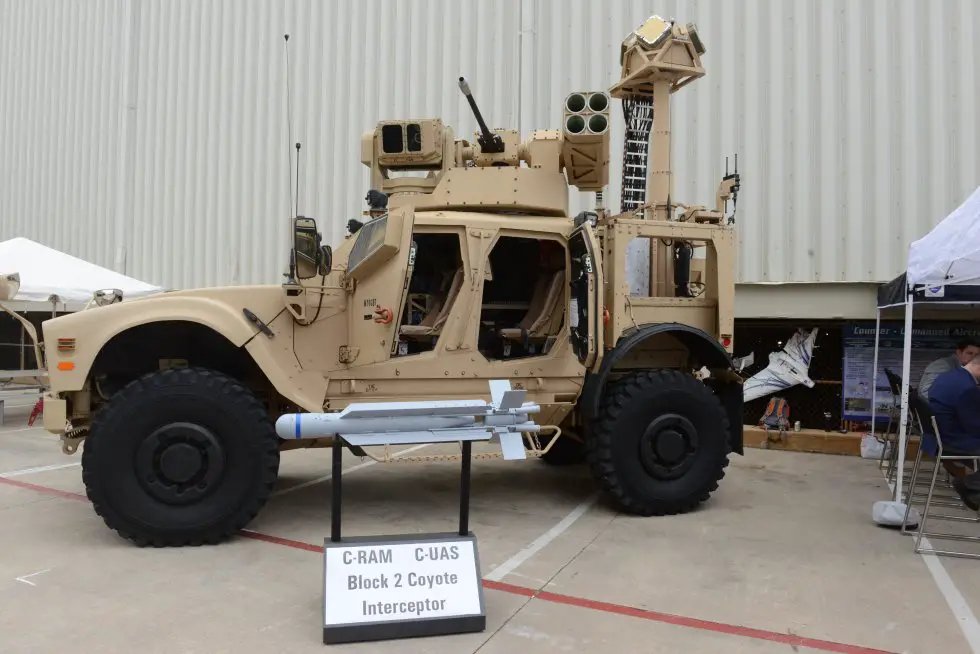Breaking news
U.S. Army's air, missile defense countering UAS threat.
The threat from enemy unmanned aerial systems continues to proliferate at an astonishing rate, said the director of the Army's newly-created Air and Missile Defense Cross-Functional Team, or AMD CFT.

A Coyote Anti-UAS Block 2 is on display at the Association of the U.S. Army's Global Force Symposium and Exposition, March 28, 2018 in Huntsville, Ala. The Coyote explodes on contact or near enemy UASs to take them out. (U.S. Army photo by David Vergun)
To counter that threat, the Army has developed a "tiered-layered approach," said Brig. Gen. Randy McIntire, who also serves as the commandant of the Air Defense Artillery School at Fort Sill, Oklahoma, and as the chief of Air Defense Artillery.
McIntire spoke last month during the Association of the U.S. Army's Global Force Symposium and Exposition here. That tiered-layered approach, he said, involves multiple countermeasures against both attack and reconnaissance unmanned aerial systems. Those countermeasures include projectiles fired from land-based Phalanx Weapons System, reconfigurable integrated-weapons platform, and the common remotely operated weapons station. All three systems can be mounted on vehicles or fixed sites.
Other countermeasures include the Compact Laser Weapon System, which can be mounted on a vehicle or fixed site, high-energy lasers, which can be mounted on vehicles as small as Strykers, the Coyote Anti-UAS, which is a UAS that crashes into enemy UAS or explodes near them, dispersing blast fragments from its warhead.
Other means are electronic warfare for attack, control or denial of UAS command link signals and video communication. Also, a host of radars for UAS detection, including M-LIDS radar, Ku radar, and even a reused version of the former Future Combat System's Multi-Mission radar.
With some 175 platforms in a single Brigade Combat Team, "we cannot have enough air defense systems out there," McIntire said, adding that the tiered-layered approach is also used against a variety of other threats, from rockets and artillery, to tactical and intercontinental ballistic missiles.
Today's battlefield, McIntire said, has become more three-dimensional, meaning that Soldiers must not only keep their eyes on ground-based threats, but also threats from the air, to include UAS.
McIntire said lasers in particular address the "cost-per-intercept," meaning that as long as it is receiving power it cannot run out of ammunition like a weapon that fires projectiles. As such, it would be useful against a swarm of UAS.
Currently, the Army has successfully demonstrated a 5-kilowatt high-energy, Stryker-mounted laser against UAS, he said. A 50kW laser mounted on a Heavy Expanded Mobility Tactical Truck was demonstrated this year, and plans are to incorporate the 50kW laser on a Stryker, which is much smaller than a HEMTT.
Fielding of 50kW Stryker-mounted lasers to BCTs could begin as early as fiscal year 2023, he added. The ultimate goal, he said, is to test a 100kW laser.
The AMD CFT, he said, is working very closely with the Next Generation Combat Vehicle CFT, with the goal of putting laser and/or projectile-based systems on future NGCV vehicles. The AMD CFT is also working closely with the Network CFT to ensure that the network used to operate all of the equipment and command and control is interoperable and secure.
Barry Pike, program executive officer, Missiles & Space, likened the UAS threat to the IED threat faced by Soldiers in Iraq and Afghanistan, with the enemy developing more powerful and sophisticated IEDs over time.
"We know how to adapt and respond [to the UAS threat] but as we do something, we know other people are going to watch what we do and they're going to respond. What we have to do is continue to think not just one step ahead but five, 10 steps ahead," he said.
Lastly, McIntire said none of the UAS countermeasures can work without the dedicated professionals who man the systems day and night.
Ever since Operation Desert Storm, that force has seen a high operations tempo, with about 60 percent forward stationed or forward deployed, he said. That's put a lot of stress on that community, and the Army G-1 and Human Resources Command are looking for ways to relieve that stress and also increase the number of incentives, he added.


























